
The offer is the final mile in your hiring process and the difference between a candidate saying “yes” today or ghosting tomorrow.
In recent years, average offer acceptance rates have hovered around 77-81%. If yours is lower, it’s a signal that something in your closing process isn’t landing. Often, the issue starts with the offer letter.
If your offer acceptance rate is low, it’s worth looking at every step of your close, and the offer letter is a good place to start.
A rushed or unclear offer letter can spark hesitation, trigger renegotiations, or even cause drop-offs. On the flip side, a clear, confident letter speeds up decision-making and builds trust right when it matters most.
In this guide, we’ll break down how to write offer letters that reinforce clarity, remove friction, and help you close top candidates faster.
Here’s the short version:
- An offer letter confirms the job, pay, start date, and terms. Keep it consistent with what was discussed.
- Use clear, human language that reflects your company’s voice. Avoid legal jargon that can create confusion or hesitation.
- Double-check every element, especially the job title, salary, and conditions, to avoid discrepancies that can derail acceptance.
- Send the letter within 24 hours of the verbal offer, include a deadline, and make the next steps easy to follow.
- A brief personal note and clear instructions on how to accept help create a smooth and confident candidate experience.
What Is an Offer Letter and What Should It Include?
An offer letter is a formal document that outlines the key terms of employment for a candidate. It’s often the first official communication they’ll receive after a verbal offer, and while it’s not always legally binding, it’s a critical moment in closing the hire.
Here’s what every offer letter should include:
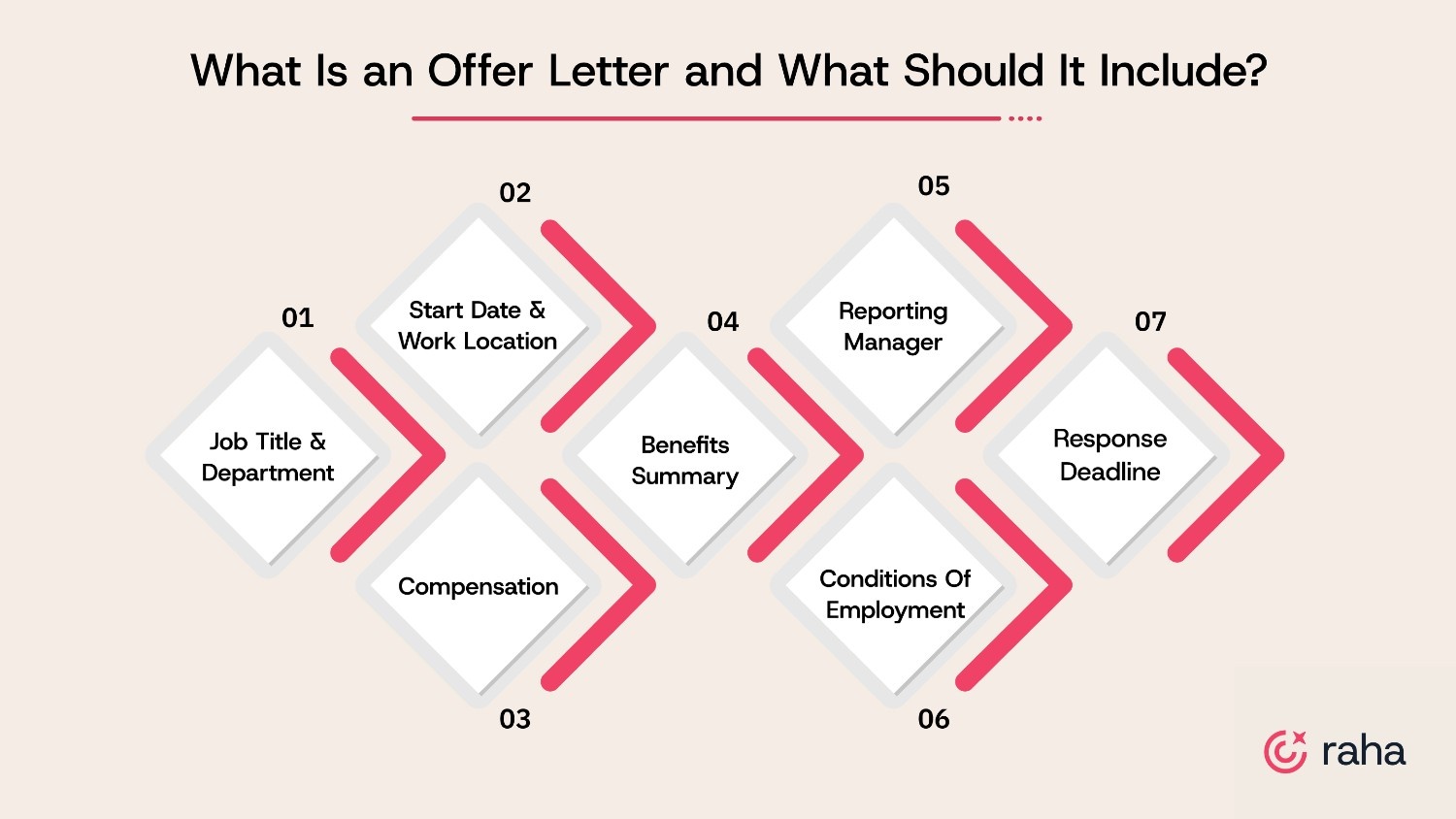
- Job Title and Department: Be specific about the role, team, and seniority level.
- Start Date and Work Location: Mention the exact start date, office location or remote status, and expected working hours.
- Compensation: Clearly break down base salary, bonuses, equity (if any), and how or when payment is made.
- Benefits Summary: Add a high-level overview or include a link to the full benefits package.
- Reporting Manager: State who the candidate will report to, along with their title.
- Conditions of Employment: Include details like background checks, reference checks, and probation period if applicable.
- Response Deadline: Set a clear deadline to accept. This creates urgency and helps forecast start dates.
You should also let the candidate know how to formally accept the offer and whom they can reach out to with any last-minute questions.
Small details like these go a long way in keeping the process smooth, professional, and candidate-friendly.
How to Write an Effective Offer Letter
You’ve sourced, screened, and interviewed. The hard part’s done.
Now it comes down to the offer letter. Long-winded language, unclear terms, or delayed communication can derail an excited candidate fast.
Here’s how to write one that gets the “yes.”
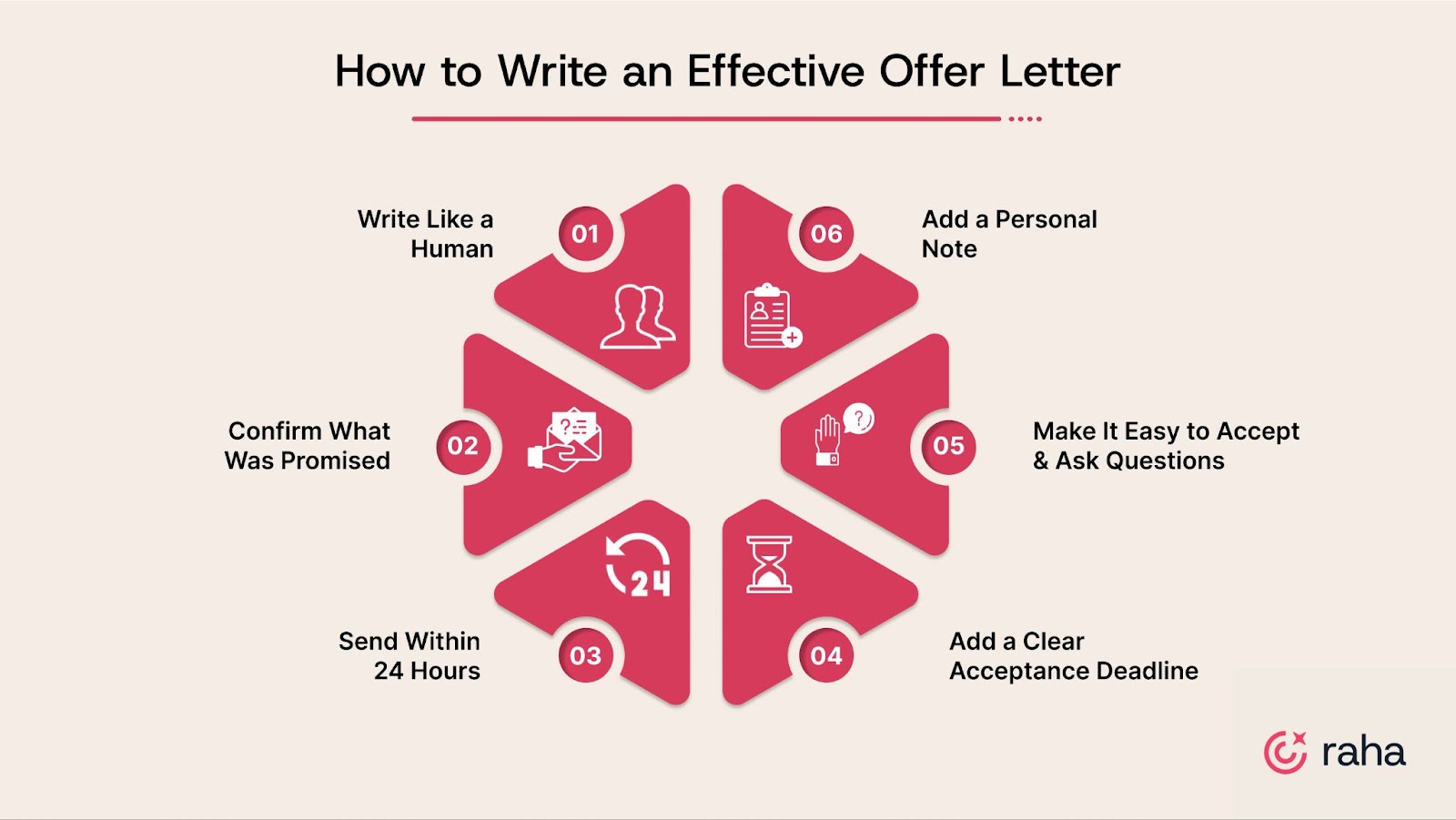
1. Write Like a Human, Not a Lawyer
Your offer letter should reflect how your company communicates. Aim for clean, professional language that’s easy to read and quick to scan. If a candidate has to slow down to interpret what you're saying, you risk losing momentum.
Here’s a quick comparison that shows how slight language changes can make your offer letter more readable.
2. Confirm Exactly What Was Promised
This is where a lot of offer letters go wrong. Even minor discrepancies—an incorrect start date, job title variation, or unclear bonus mention—can trigger hesitation.
What to check:
- Is the base salary accurate and clearly stated?
- Is the job title identical to the one used in the JD and verbal offer?
- Are any variable pay elements (bonuses, stock) included and explained?
Tip: Always cross-reference the verbal offer and the job description before sending the letter.
3. Send It Within 24 Hours of the Verbal Offer
A fast offer letter shows you're organized, decisive, and excited about the hire. Delays, even 48 hours, can cool candidate excitement or open the door to competing offers.
What you should do:
Send the letter the same day the verbal offer is accepted, or within 24 hours max. If there’s a known delay, like final budget sign-off, proactively tell the candidate when to expect the letter.
4. Include a Clear Deadline for Acceptance
Setting a deadline gives candidates the nudge they need to respond promptly. Two to four business days is the sweet spot. It gives space for review without dragging out your hiring timeline.
Tip: Combine a deadline with a supportive line.
“If you have any questions as you review, feel free to reach out. We’re here to help.”
5. Make It Easy to Accept and Ask Questions
If a candidate has to guess what to do next, you're slowing things down. Spell out the steps to accept the offer, whether that means replying to the email, signing digitally, or logging into a portal.
Also, make sure they know who to contact if they have questions or concerns.
Use this checklist to cover your bases:
- Include a direct e-signature link or clearly state “Reply to this email to accept.”
- Mention the name and contact information of the recruiter or hiring manager for questions.
- Add a line like “Once you accept, we’ll schedule your onboarding session within 2–3 days.”
- Confirm that the candidate has access to the portal, document viewer, or tool (e.g., Greenhouse, Lever, DocuSign).
- If applicable, mention any offer expiration date or deadline.
6. Add a Personal Note
Offer letters are transactional by nature. A short message from the hiring manager or recruiter reinforces that this is a team decision and the team is excited.
An effective offer letter does three things well. It confirms the details, keeps the momentum, and makes the candidate feel chosen, not just selected.
Also read: The Best AI Tools for Smarter, Faster Sourcing in 2025
Offer Letter Templates (That Actually Save You Time)
A well-structured template keeps you compliant, consistent, and fast, especially when you’re hiring at scale or across regions. Below are two sample templates: one for full-time roles and one for contract positions. Use them as a starting point and tailor them based on role, seniority, and geography.
1. Full-Time Employee Offer Letter Template
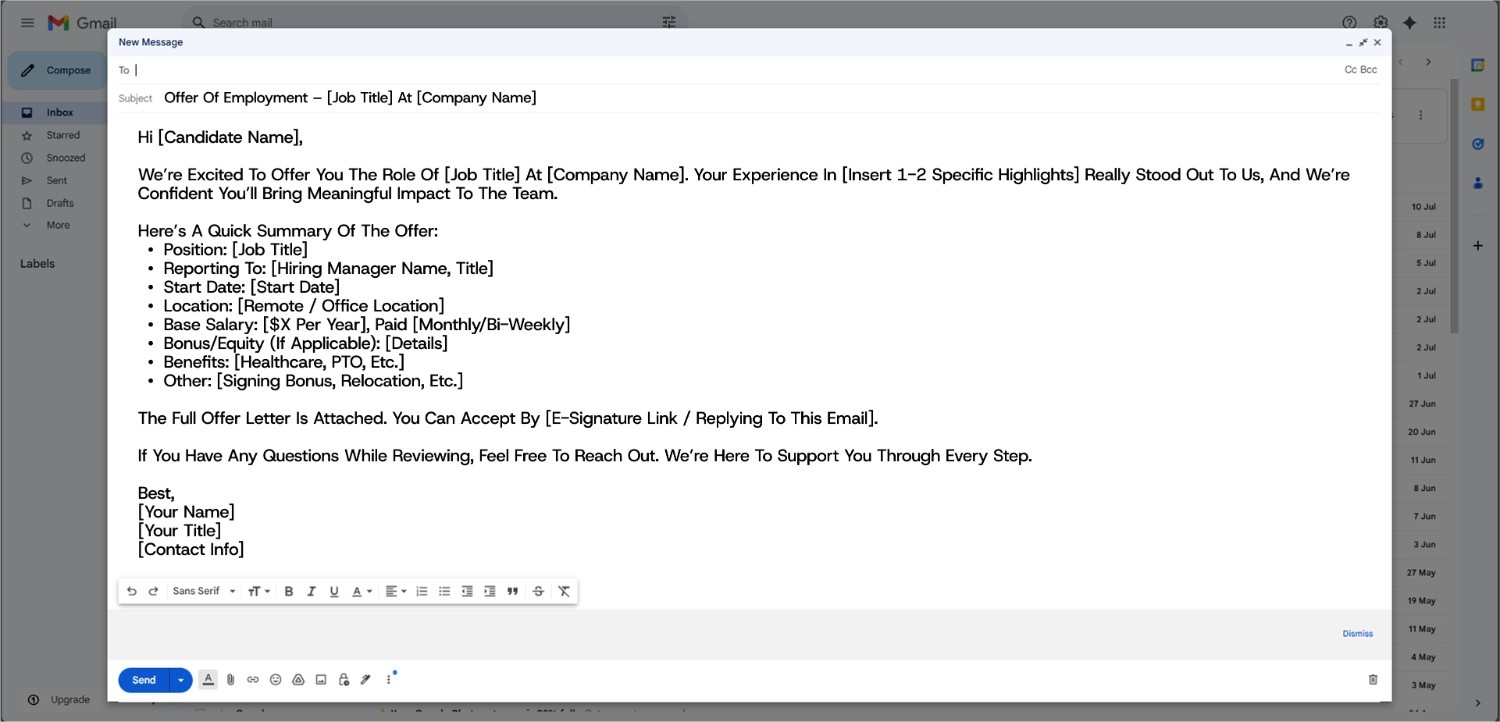
Subject: Offer of Employment – [Job Title] at [Company Name]
Hi [Candidate Name],
We’re excited to offer you the role of [Job Title] at [Company Name]. Your experience in [insert 1-2 specific highlights] really stood out to us, and we’re confident you’ll bring meaningful impact to the team.
Here’s a quick summary of the offer:
- Position: [Job Title]
- Reporting to: [Hiring Manager Name, Title]
- Start Date: [Start Date]
- Location: [Remote / Office Location]
- Base Salary: [$X per year], paid [monthly/bi-weekly]
- Bonus/Equity (if applicable): [Details]
- Benefits: [Healthcare, PTO, etc.]
- Other: [Signing bonus, relocation, etc.]
The full offer letter is attached. You can accept by [e-signature link / replying to this email].
If you have any questions while reviewing, feel free to reach out. We’re here to support you through every step.
Best,
[Your Name]
[Your Title]
[Contact Info]
2. Contractor Offer Letter Template
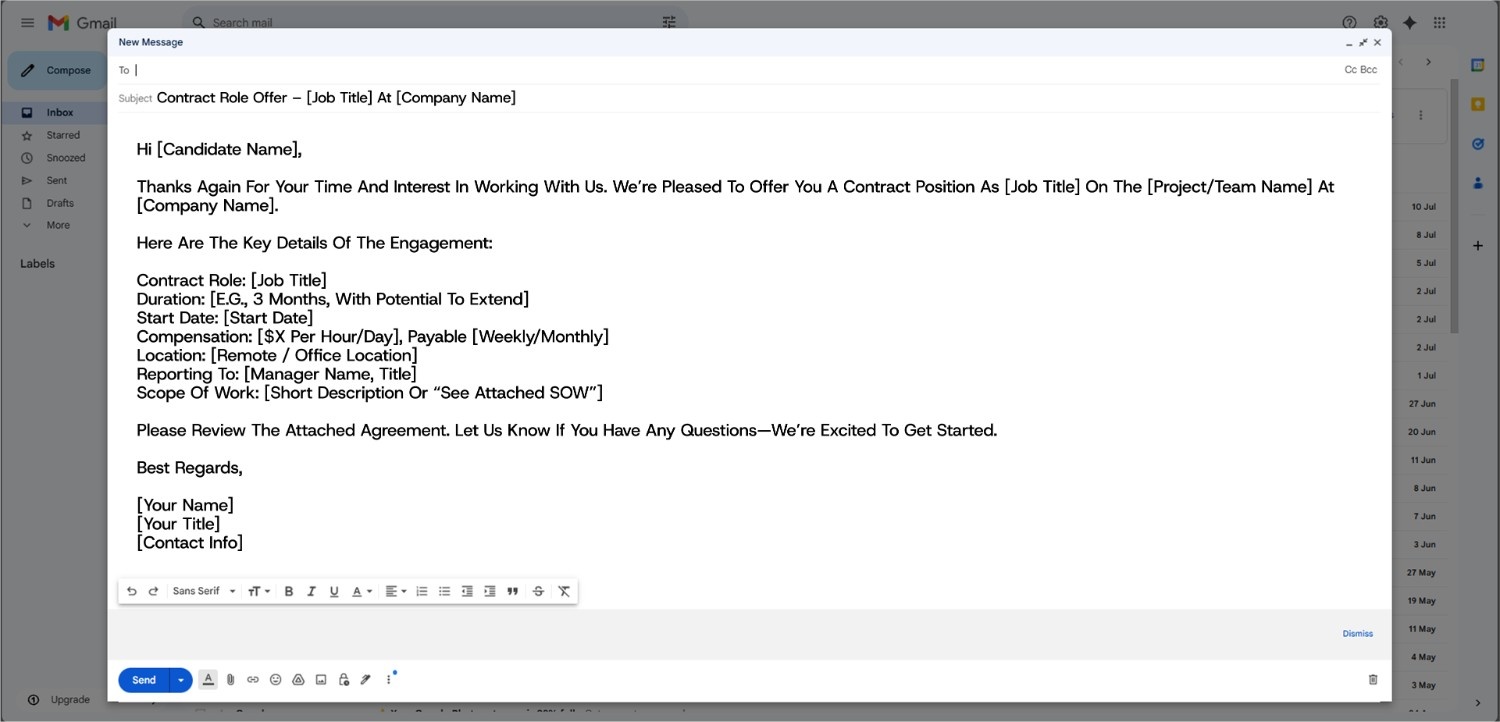
Subject: Contract Role Offer – [Job Title] at [Company Name]
Hi [Candidate Name],
Thanks again for your time and interest in working with us. We’re pleased to offer you a contract position as [Job Title] on the [Project/Team Name] at [Company Name].
Here are the key details of the engagement:
Contract Role: [Job Title]
Duration: [e.g., 3 months, with potential to extend]
Start Date: [Start Date]
Compensation: [$X per hour/day], payable [weekly/monthly]
Location: [Remote / Office Location]
Reporting to: [Manager Name, Title]
Scope of Work: [Short description or “See attached SOW”]
Please review the attached agreement. Let us know if you have any questions—we’re excited to get started.
Best regards,
[Your Name]
[Your Title]
[Contact Info]
You’ve got the offer letter drafted. But unless it reaches the right candidate quickly, it won’t matter. Smart tools like Raha AI help you reach that point faster by automating interviews, screening, and scheduling.
Let’s take a look.
Also read: Time to Fill in Recruitment: How to Track, Benchmark & Fix It
Improve Your Hiring Workflow with Raha AI
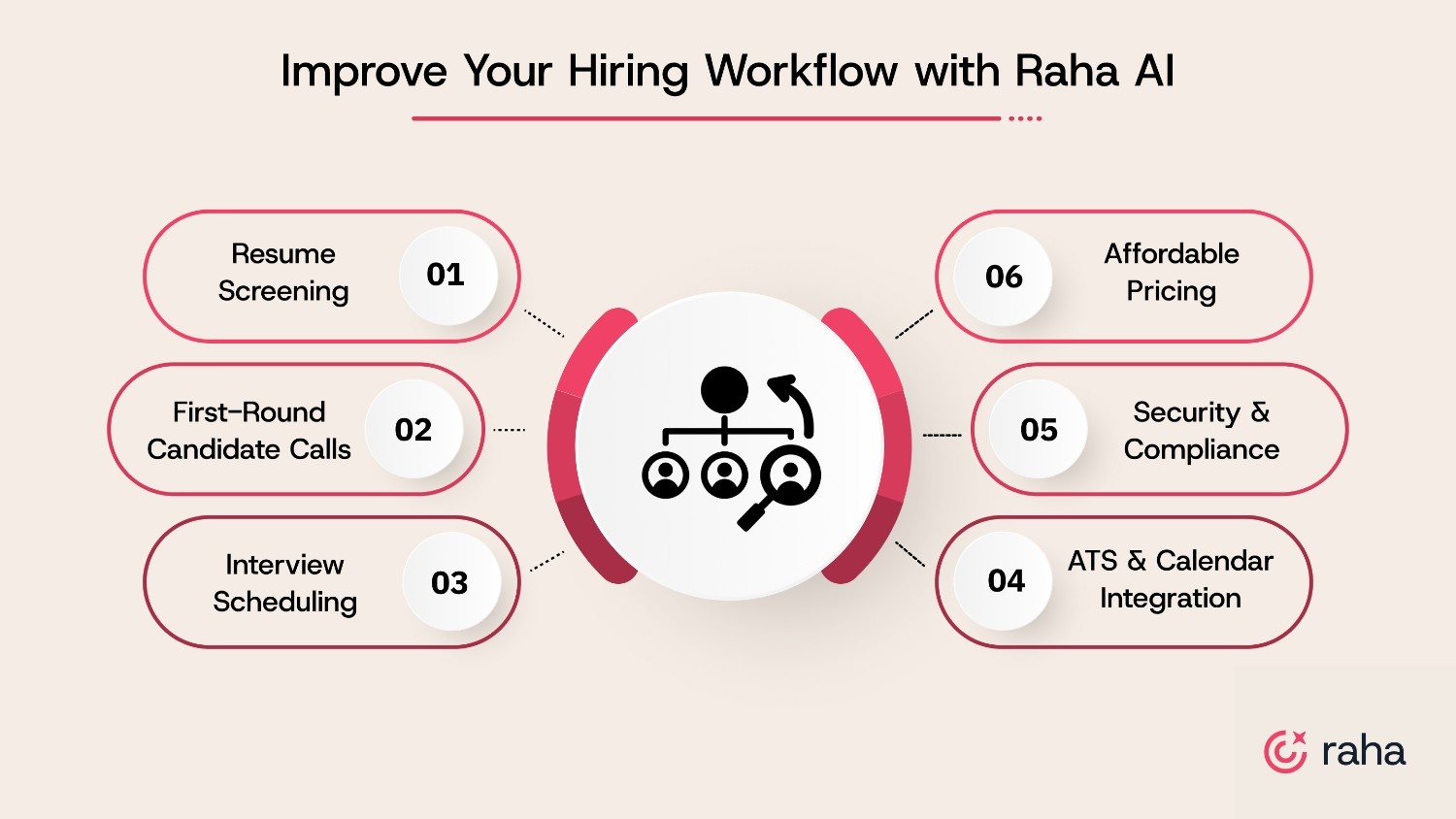
Raha is an AI recruiting assistant designed to support modern TA teams by automating the three most time-consuming parts of hiring:
- Resume Screening: Parses applications and extracts key data points across all candidate resumes, scores them based on fit, and lets you filter and shortlist in minutes.
- First-Round Candidate Calls: Conducts structured 10–15 minute phone and video screenings using custom or AI-suggested questions and generates fitment reports you can use to decide who advances.
- Interview Scheduling: Handles full coordination, i.e., reaching out to candidates and interviewers, collecting availability, sending invites, and managing follow-ups, with zero back-and-forth.
- ATS & Calendar Integration: Plugs into your ATS, email, and calendar tools so you don’t have to switch systems or workflows.
- Security & Compliance: Fully compliant with SOC 2 Type II, GDPR, and HIPAA standards.
- Affordable Pricing: Start with 10 interviews free. After that, it’s just $1 per interview.
Whether you’re still hiring or gearing up for future roles, Raha AI helps you move faster without burning out your team — automating 90% of interview coordination and helping companies fill roles 15 days faster.
Run Your Hiring Process The Right Way
A strong offer letter helps you close fast, but it only works when everything leading up to it runs smoothly.
If you’re constantly re-checking comp numbers, chasing approvals, or sending letters days late, the real issue isn’t the letter – it’s the workflow behind it.

Raha AI streamlines the entire hiring journey from first touch to final offer. It automates screening, interview scheduling, and coordination so you can move faster and close with confidence.
Start with 10 interviews free. Try Raha AI today.
FAQs
1. Does getting an offer letter mean you got the job?
Yes, an offer letter means the company has officially selected you for the role. It confirms your employment, pending any final steps like background checks or signed acceptance.
2. What is an example of an offer letter?
An offer letter usually opens with a congratulatory line, then lists the job title, start date, salary, benefits, and who you’ll report to. It may include contingencies (like background checks) and steps to accept the offer. You can find downloadable templates [here].
3. How do I get an offer letter for my job?
Once a company chooses you for the position, HR or the recruiter will typically email your offer letter. If you’ve been verbally offered the job but haven’t received a letter, it’s fine to follow up and request it in writing.
4. Is an offer letter legally binding?
Most offer letters aren’t full legal contracts, though they do outline what was verbally agreed. They establish expectations, and any inaccuracies (for example, a different title or salary) can lead to renegotiation or rejection.

